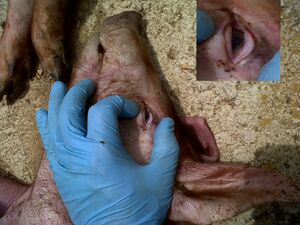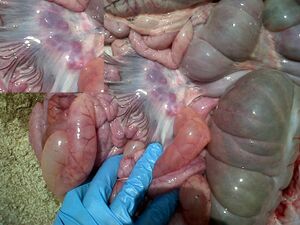Oedema Disease
Jump to navigation
Jump to search
Also known as: Edema Disease
Introduction
Edema disease is a enterotoxemia of weaned piglets caused by a serotypes of Escherichia coli. It is a acute pathology which clinical signs are edema in some regions of the animal, nervous disorders and sudden deaths.
* Catarrhal gastritis is an important characterisitic of this condition
- Oedema disease is a sporadic condition that can become important on some farms.
Clinical
- Generally occurs in young pigs, though sometimes in older pigs
- 7-10 days after major change in diet e.g. weaning.
- Signs include
- No diarrhoea
- Puffy eyelids
- High-pitched voice (oedema of larynx)
- Sitting on haunched
- "Star-gazing" due to cerebral oedema (hallucinations?).
- Animals usually die.
- Disease develops very quickly so pigs do not have time to go off food.
Pathogenesis
- Oedema disease is an enterotoxaemia associated with infection by enterotoxigenic E.coli.
- Verotoxin/ shiga toxin- producing E. coli proliferate in the small intestine
- Especially O138, O139, and O141.
- Organisms remain in the gut (are not invasive).
- Labile shiga-like toxin II is absorbed into body, producing effects everywhere.
- Blood vessel walls are damaged and become very leaky, producing oedema everywhere.
- Histological blood vessel changes are subtle.
- Fibrinoid degeneration of media in small arteries.
Pathology
- An important characteristic of oedema disease is the occurrence of catarrhal gastritis and marked oedema in the stomach mucosa and wall.
- Also oedema of various organs, particularly between coils of spiral colon.
Diagnosis
- Clinical signs are characteristic.
- Also by culture and typing of E. coli from gut
- Acute, frequently fatal enterotoxaemia of weaned pigs
- Associated with particular haemolytic serotypes of E. coli
- Verotoxin (Shiga toxin II e) released in the small intestine and carried in the bloodstream
- Haemolysin production
- Subcutaneous and subserosal oedema
- Peracute disease affecting particulary healthy piglets
- Mortality rate 30%-90%
- Antimicrobial treatment effective if administered in time

